|
|
|
Sort Order |
|
|
|
Items / Page
|
|
|
|
|
|
|
| Srl | Item |
| 1 |
ID:
162412
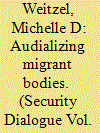

|
|
|
|
|
| Summary/Abstract |
Sound represents a salient yet rarely examined counterpoint to visuality and materiality in security, international bordering, and mobility literature. Using the context of sub-Saharan African migration as grounding for empirical analysis and drawing on fieldwork conducted in Morocco in 2015 and 2016, this article lays the foundation for a research agenda that understands voice, and the sonic body more broadly, as mechanisms of political power. In examining the central roles that sound, hearing, and voice play in strategies of individual resistance at border crossings, as well as in state, private, and transnational communication and surveillance regimes, it attends to the ways in which sound and the audialized body reconfigure power relations, and structure mobility and personal identity. This analysis contributes to the growing literature addressing biometric borders and the deterritorialization of security practices, and argues that sound, along with more familiar nodes of securitization, constitutes a critical site of governmentality and therefore of ethical and moral negotiation.
|
|
|
|
|
|
|
|
|
|
|
|
|
|
|
|
| 2 |
ID:
172041
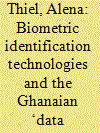

|
|
|
|
|
| Summary/Abstract |
In the global effort to strengthen national identification systems (SDG 16.9), biometric identification technologies and civil registration systems have been associated with different motives and applications, thus fuelling their competition for public attention and resources. The case of Ghana illustrates how these alternative systems, along with further sources of personal data, have recently been integrated into the larger political vision of a centralised, national population data system. Based on ethnographic fieldwork, the paper traces the difficulties and institutional negotiations that accompany this integration into a centralised population data infrastructure. Acknowledging how sets of actors, infrastructures and power relations are layered onto each other to unintended effects, the article describes the historical process of institutional and infrastructural harmonisation in the production of biometric population registers in Ghana.
|
|
|
|
|
|
|
|
|
|
|
|
|
|
|
|
| 3 |
ID:
149004
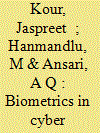

|
|
|
|
|
| Summary/Abstract |
Computers play an important role in our daily lives and its usage has grown manifolds today. With ever increasing demand of security regulations all over the world and large number of services provided using the internet in day to day life, the assurance of security associated with such services has become a crucial issue. Biometrics is a key to the future of data/cyber security. This paper presents a biometric recognition system which can be embedded in any system involving access control, e-commerce, online banking, computer login etc. to enhance the security. Fingerprint is an old and mature technology which has been used in this work as biometric trait. In this paper a fingerprint recognition system based on no minutiae features: Fuzzy features and Invariant moment features has been developed. Fingerprint images from FVC2002 are used for experimentation. The images are enhanced for improving the quality and a region of interest (ROI) is cropped around the core point. Two sets of features are extracted from ROI and support vector machine (SVM) is used for verification. An accuracy of 95 per cent is achieved with the invariant moment features using RBF kernel in SVM.
|
|
|
|
|
|
|
|
|
|
|
|
|
|
|
|
| 4 |
ID:
151022


|
|
|
| 5 |
ID:
190677
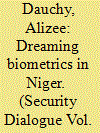

|
|
|
|
|
| Summary/Abstract |
Since 2015, Niger has been actively committed to migration control in West Africa in the context of the European Union Emergency Trust Fund for Africa. To enable better comprehension of the making of security in Niger, this article studies the implementation of biometrics under the EU Trust Fund by international agencies (Interpol, the International Organization for Migration, UNHCR) and national actors. Drawing on in-depth interviews, observation and anthropology of aid studies, I argue that biometrics is a travelling organizational model translated into a multiscalar process by state and non-state actors embedded in relations of power. Biometric technologies cannot be reduced to an added-value instrument for Nigerien authorities in order to enhance legibility, to better identify Nigeriens and foreigners crossing Niger’s borders within the free-movement area of ECOWAS (Economic Community of West African States). I focus on heterogeneous actors’ situated discourses and practices to demonstrate that they do not share the same dream about biometrics. In practice, however, biometrics helps international actors to produce their own security knowledge in Niger that, in the end, augments the capacity to trace ECOWAS citizens and reinforce the EU border regime.
|
|
|
|
|
|
|
|
|
|
|
|
|
|
|
|
| 6 |
ID:
138070
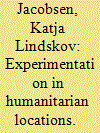

|
|
|
|
|
| Summary/Abstract |
Amid good intentions, such as providing humanitarian assistance to refugees, the use of biometric technology in humanitarian refugee management may entail various risks for the implicated refugee populations. Drawing on insights from science and technology studies, this article introduces a distinction between risks stemming from technology failure and risks stemming from successful uses of biometric technology. The article thus departs from the literature in which technology failure has been in focus by showing that analysing the effect of technology success adds an important dimension to our analysis of the range of risks that may emerge in the context of humanitarian technology uses. The usefulness of this distinction is then illustrated through an analysis of the use by the United Nations High Commissioner for Refugees (UNHCR) of iris recognition in the repatriation of Afghan refugees; besides risks of failure at the implementation stage, risks also emerged once refugees had successfully registered their biometric data with UNHCR. To recognize how humanitarian refugee biometrics produces digital refugees at risk of exposure to new forms of intrusion and insecurity, we need to appreciate how successful technology can have critical implications arising from how technology is constituted in and constitutive of social phenomena.
|
|
|
|
|
|
|
|
|
|
|
|
|
|
|
|
| 7 |
ID:
184314
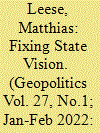

|
|
|
|
|
| Summary/Abstract |
Building on Scott’s notion of identity as a key concept in early modern statehood, this paper historically contextualises and analyses the current political re-problematisation of identity in the EU. Engaging the recently adopted interoperability initiative that is set to biometrically verify and cross-validate identity records between all European border management, migration, and security databases, it argues that interoperability presents a shift from traditional modes of identity production at the border towards a digital space of identity management. Such identity management is predicated on the establishment of a biometric super-layer structure that cuts across databases without dissolving their legal foundations and introduces a new mode of ‘truth’ production in the form of a dedicated ‘identity confirmation file’ that is supposed to re-introduce a reliable baseline for the government of the Schengen area.
|
|
|
|
|
|
|
|
|
|
|
|
|
|
|
|
| 8 |
ID:
167095
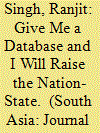

|
|
|
|
|
| Summary/Abstract |
This paper draws on an ethnographic study of Aadhaar, India’s biometrics-based national identification infrastructure, to investigate how members of its design team conceptualised and understood their techno-bureaucratic enterprise of assigning unique numbers to Indian residents. Members described their work using the metaphor of building an hour-glass: the Aadhaar number and its authentication services constitute the waist of this hour-glass; below were innovations in biometric devices and above were applications requiring identity verification services. They believed the entire ecosystem sustaining Aadhaar could be controlled by prescribing interactions between the waist and the components above and below. They extended this metaphor to reimagine the Indian government as a platform of services controlling only a specific part of a service—the waist—while opening space for innovation by integrating it with other market services above and below. This paper documents the emergence of this imaginary of ‘platformised’ government collecting real-time citizen data to support personalised state–citizen interactions to unpack how the future(s) of Indian government services shapes and is shaped by it. Such future(s) constitute the Indian population as a database, bureaucracies as centralised dashboards, and government as arbiter in the circulation of citizen data.
|
|
|
|
|
|
|
|
|
|
|
|
|
|
|
|
| 9 |
ID:
167096
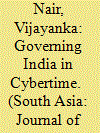

|
|
|
|
|
| Summary/Abstract |
Building on anthropological attention that has been devoted, appropriately, to the question of how states are spatialised, this article analyses how the swirl of discourse and everyday practice around India’s biometric identification programme serves to temporalise the state. The first half of the article examines how the Aadhaar initiative endeavours to assign the temporalising characteristics of innovativeness and expeditiousness to the contemporary Indian state. I show how mobility, change and speed are motivating factors for personnel at the Unique Identification Authority of India (UIDAI). In turn, I argue that Aadhaar is emblematic of the reimagination of the Indian state as a ‘start-up state’, or a lithe platform for innovation. I then explore the ways in which this start-up state is constructed in what one might call ‘cybertime’—a mode of imagining time that unsettles received understandings of historical time. In the second half of the article, I investigate how centralised efforts to temporalise the state are experienced by local implementers of Aadhaar as well as by its targets.
|
|
|
|
|
|
|
|
|
|
|
|
|
|
|
|
| 10 |
ID:
138633


|
|
|
|
|
| Summary/Abstract |
Biometrics is the science of identifying a person using physiological or behavioural characteristics. Hand vein pattern is a recent and unique biometric feature which is used for high secure authentication of individuals. The dorsal hand contains dorsal metacarpal veins, dorsal venous network, cephalic vein and basilic vein. This paper presents an image descriptor which uses statistical structure of natural images. In this work, stack of natural image patches are used as filters and these transform an image into integer labels describing the small-scale appearance of the image. These labels are converted into histogram and it is used for further image analysis. The feature space contains binarized statistical image features. The proposed work is tested on NCUT dataset with state-of-the-art algorithms. The experimental results demonstrate that the proposed work outperforms of the state-of-the-art algorithms with the recognition rate of 99.80 per cent.
|
|
|
|
|
|
|
|
|
|
|
|
|
|
|
|
| 11 |
ID:
118067
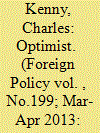

|
|
|
| 12 |
ID:
167097
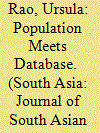

|
|
|
|
|
| Summary/Abstract |
This article traces the processes of making identities in digital India. By zooming into the two processes of enrolling in and using Aadhaar, it questions the distinction between identification and identity that pervades discussions of new technologies and shows that all Aadhaar-related procedures are productive of identity as a socially mediated process of creating or denying the condition for belonging. Following the introduction of Aadhaar, becoming a rights-bearing individual, for the most part, involves stitching together three types of identities: (1) a digital signature with (2) documentary proof of identity, both of which are based on (3) personal recognition. Aadhaar, then, does not change the ground on which official identity routines are built, but it alters the technical terrain people must navigate to become rights-bearing citizens. It adds a new layer of procedures on top of older techniques of recognition by insisting that persons must always be seen as unique individuals alongside being recognised as people holding a specific status.
|
|
|
|
|
|
|
|
|
|
|
|
|
|
|
|
| 13 |
ID:
081453
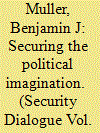

|
|
|
|
|
| Publication |
2008.
|
| Summary/Abstract |
What is the relationship between popular culture and the reliance on risk management as a framework for governance in the emerging security dispositif? Furthermore, how is one to understand the influence of culture and cultural forces in relation to the emerging biometric state and the alleged security imperatives therein? This article contends that the emerging security dispositif, and the associated imaginations and cultural performances that sustain and shape it, are vital to the production of what is referred to here as the `biometric state'. Motivated by an obsession with technologies of risk and practices of risk management, the biometric state is defined by the prevalence of virtual borders and reliance on biometric identifiers such as passports, trusted-traveller programmes and national ID cards, as well as the forms of social sorting that accompany these manoeuvres. Raising the marriage of convenience that connects two related dispositifs of security - geopolitics and biopolitics - the article considers the relationship between their referent objects: the state and everyday life, respectively. More specifically, popular culture integral to sustaining the emerging security dispositif forms the core of the analysis, as the article asserts the constitutive possibilities of popular culture
|
|
|
|
|
|
|
|
|
|
|
|
|
|
|
|
| 14 |
ID:
167094
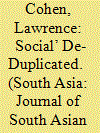

|
|
|
|
|
| Summary/Abstract |
India’s programme for biometric registration, Aadhaar, is organised through engineering concept work that depends upon three distinctive claims for the ‘social’ as human condition: (1) the social as ‘socialism’, the failed premise of Nehruvian decolonisation understood to have placed the poor into a condition of bare life; (2) the social-yet-to-come as the effect of a proper distribution of the good termed ‘service’, to bring the poor into a self-ameliorating form of life; and (3) the social as the affective entanglements that family, caste and religious ties of biography demand, ties that divert service from proper distribution. Within the concept-world of Aadhaar, such entanglements prevent the social-yet-to-come, demanding a form of government that can produce a political subject outside of biography, which for the engineers is achieved by conceiving of India as a database, an archive prone to the duplication of its elements, and thus governing India as one would govern a database: by continually ‘de-duplicating’ it.
|
|
|
|
|
|
|
|
|
|
|
|
|
|
|
|
| 15 |
ID:
163053
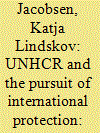

|
|
|
|
|
| Summary/Abstract |
Better management and new technological solutions are increasingly portrayed as the way to improve refugee protection and enhance the accountability of humanitarian actors. Taking concepts of legibility, quantification and co-production as the point of departure, this article explores how techno-bureaucratic practices shape conceptions of international refugee protection. We do this by examining the evolving roles of results-based management (RBM), biometrics and cash-based interventions as ‘accountability technologies’ in the United Nations High Commissioner for Refugees’ international protection efforts. The article challenges the assumption that these technologies produce a seamless form of accountability that is equally attentive to donor requests and the protection needs of refugees. By focusing on how the constitution of these techniques as ‘accountability solutions’ shapes conceptions of the very meaning of protection (ie the problem to be addressed), we also show what dimensions of protection get omitted in this co-production of technical solutions and socio-political problems.
|
|
|
|
|
|
|
|
|
|
|
|
|
|
|
|
| 16 |
ID:
117607
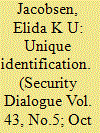

|
|
|
|
|
| Publication |
2012.
|
| Summary/Abstract |
The last decade has seen an increased focus on secured forms of identification in security governance, leading to a massive growth and standardization in the application of biometric technologies globally. This article examines what is currently the largest biometric technology project in the world: the nationwide Unique Identification (UID) number system in India. It emphasizes the importance of investigating the postcolonial contexts of governance in which biometric technology is currently being applied. Approaching the Indian scheme as a discursive/practical assemblage of multiple actors and rationales, the article investigates three contexts within which the biometric project emerged: India's Home Ministry, the Unique Identification Authority of India and a project focusing on the biometric identification of homeless people in Delhi. In particular, the article examines the various targets of intervention constructed in the discourses and practices of the national ID scheme. It is argued that the practice of biometric identification is produced as a solution to a wide array of problems of governance, both as a means of financial inclusion and as a method of surveillance.
|
|
|
|
|
|
|
|
|
|
|
|
|
|
|
|
| 17 |
ID:
143734
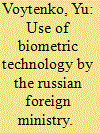

|
|
|
|
|
| Summary/Abstract |
SECURITY has always been a key point of the foreign policy of any state. In this era of globalization, classical diplomacy is not the only method used by world powers to keep themselves secure. They also make extensive use of alternative efficient ways of handling modern threats and challenges.
|
|
|
|
|
|
|
|
|
|
|
|
|
|
|
|
|
|
|
|
|